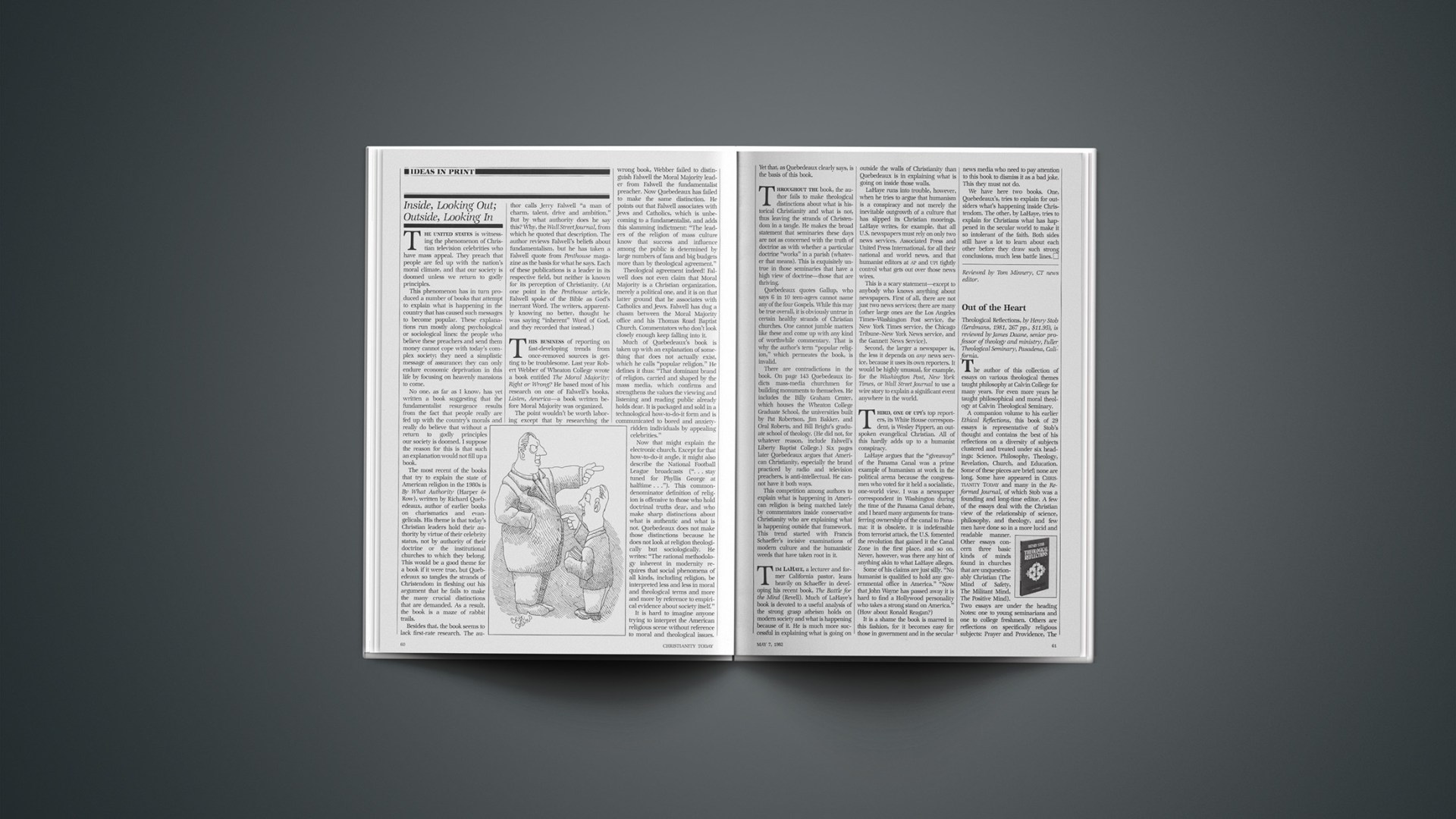Inside, Looking Out; Outside, Looking In
The united states is witnessing the phenomenon of Christian television celebrities who have mass appeal. They preach that people are fed up with the nation’s moral climate, and that our society is doomed unless we return to godly principles.
This phenomenon has in turn produced a number of books that attempt to explain what is happening in the country that has caused such messages to become popular. These explanations run mostly along psychological or sociological lines: the people who believe these preachers and send them money cannot cope with today’s complex society; they need a simplistic message of assurance; they can only endure economic deprivation in this life by focusing on heavenly mansions to come.
No one, as far as I know, has yet written a book suggesting that the fundamentalist resurgence results from the fact that people really are fed up with the country’s morals and really do believe that without a return to godly principles our society is doomed. I suppose the reason for this is that such an explanation would not fill up a book.
The most recent of the books that try to explain the state of American religion in the 1980s is By What Authority (Harper & Row), written by Richard Quebedeaux, author of earlier books on charismatics and evangelicals. His theme is that today’s Christian leaders hold their authority by virtue of their celebrity status, not by authority of their doctrine or the institutional churches to which they belong. This would be a good theme for a book if it were time, but Quebedeaux so tangles the strands of Christendom in fleshing out his argument that he fails to make the many crucial distinctions that are demanded. As a result, the book is a maze of rabbit trails.
Besides that, the book seems to lack first-rate research. The author calls Jerry Falwell “a man of charm, talent, drive and ambition.” But by what authority does he say this? Why, the Wall Street Journal, from which he quoted that description. The author reviews Falwell’s beliefs about fundamentalism, but he has taken a Falwell quote from Penthouse magazine as the basis for what he says. Each of these publications is a leader in its respective field, but neither is known for its perception of Christianity. (At one point in the Penthouse article, Falwell spoke of the Bible as God’s inerrant Word. The writers, apparently knowing no better, thought he was saving “inherent” Word of God, and they recorded that instead.)
This business of reporting on fast-developing trends from once-removed sources is getting to be troublesome. Last year Robert Webber of Wheaton College wrote a book entitled The Moral Majority: Right or Wrong? He based most of his research on one of Falwell’s books, Listen, America—a book written before Moral Majority was organized.
The point wouldn’t be worth laboring except that by researching the wrong book, Webber failed to distinguish Falwell the Moral Majority leader from Falwell the fundamentalist preacher. Now Quebedeaux has failed to make the same distinction. He points out that Falwell associates with Jews and Catholics, which is unbecoming to a fundamentalist, and adds this slamming indictment: “The leaders of the religion of mass culture know that success and influence among the public is determined by large numbers of fans and big budgets more than by theological agreement.”
Theological agreement indeed! Falwell does not even claim that Moral Majority is a Christian organization, merely a political one, and it is on that latter ground that he associates with Catholics and Jews. Falwell has dug a chasm between the Moral Majority office and his Thomas Road Baptist Church. Commentators who don’t look closely enough keep falling into it.
Much of Quebedeaux’s book is taken up with an explanation of something that does not actually exist, which he calls “popular religion.” He defines it thus: “That dominant brand of religion, carried and shaped by the mass media, which confirms and strengthens the values the viewing and listening and reading public already holds dear. It is packaged and sold in a technological how-to-do-it form and is communicated to bored and anxiety-ridden individuals by appealing celebrities.”
Now that might explain the electronic church. Except for that how-to-do-it angle, it might also describe the National Football League broadcasts (“… stay tuned for Phyllis George at halftime …”). This common-denominator definition of religion is offensive to those who hold doctrinal truths dear, and who make sharp distinctions about what is authentic and what is not. Quebedeaux does not make those distinctions because he does not look at religion theologically but sociologically. He writes: “The rational methodology inherent in modernity requires that social phenomena of all kinds, including religion, be interpreted less and less in moral and theological terms and more and more by reference to empirical evidence about society itself.” It is hard to imagine anyone trying to interpret the American religious scene without reference to moral and theological issues. Yet that, as Quebedeaux clearly says, is the basis of this book.
Throughout the book, the author fails to make theological distinctions about what is historical Christianity and what is not, thus leaving the strands of Christendom in a tangle. He makes the broad statement that seminaries these days are not as concerned with the truth of doctrine as with whether a particular doctrine “works” in a parish (whatever that means). This is exquisitely untrue in those seminaries that have a high view of doctrine—those that are thriving.
Quebedeaux quotes Gallup, who says 6 in 10 teen-agers cannot name any of the four Gospels. While this may be true overall, it is obviously untrue in certain healthy strands of Christian churches. One cannot jumble matters like these and come up with any kind of worthwhile commentary. That is why the author’s term “popular religion,” which permeates the book, is invalid.
There are contradictions in the book. On page 143 Quebedeaux indicts mass-media churchmen for building monuments to themselves. He includes the Billy Graham Center, which houses the Wheaton College Graduate School, the universities built by Pat Robertson, Jim Bakker, and Oral Roberts, and Bill Bright’s graduate school of theology. (He did not, for whatever reason, include Falwell’s Liberty Baptist College.) Six pages later Quebedeaux argues that American Christianity, especially the brand practiced by radio and television preachers, is anti-intellectual. He cannot have it both ways.
This competition among authors to explain what is happening in American religion is being matched lately by commentators inside conservative Christianity who are explaining what is happening outside that framework. This trend started with Francis Schaeffer’s incisive examinations of modern culture and the humanistic weeds that have taken root in it.
Tim LaHaye, a lecturer and former California pastor, leans heavily on Schaeffer in developing his recent book, The Battle for the Mind (Revell). Much of LaHaye’s book is devoted to a useful analysis of the strong grasp atheism holds on modern society and what is happening because of it. He is much more successful in explaining what is going on outside the walls of Christianity than Quebedeaux is in explaining what is going on inside those walls.
LaHaye runs into trouble, however, when he tries to argue that humanism is a conspiracy and not merely the inevitable outgrowth of a culture that has slipped its Christian moorings. LaHaye writes, for example, that all U.S. newspapers must rely on only two news services, Associated Press and United Press International, for all their national and world news, and that humanist editors at AP and UPI tightly control what gets out over those news wires.
This is a scary statement—except to anybody who knows anything about newspapers. First of all, there are not just two news services; there are many (other large ones are the Los Angeles Times-Washington Post service, the New York Times service, the Chicago Tribune-New York News service, and the Gannett News Service).
Second, the larger a newspaper is, the less it depends on any news service, because it uses its own reporters. It would be highly unusual, for example, for the Washington Post, New York Times, or Wall Street Journal to use a wire story to explain a significant event anywhere in the world.
Third, one of upi’s top reporters, its White House correspondent, is Wesley Pippert, an outspoken evangelical Christian. All of this hardly adds up to a humanist conspiracy.
LaHaye argues that the “giveaway” of the Panama Canal was a prime example of humanism at work in the political arena because the congressmen who voted for it held a socialistic, one-world view. I was a newspaper correspondent in Washington during the time of the Panama Canal debate, and I heard many arguments for transferring ownership of the canal to Panama: it is obsolete, it is indefensible from terrorist attack, the U.S. fomented the revolution that gained it the Canal Zone in the first place, and so on. Never, however, was there any hint of anything akin to what LaHaye alleges.
Some of his claims are just silly. “No humanist is qualified to hold any governmental office in America.” “Now that John Wayne has passed away it is hard to find a Hollywood personality who takes a strong stand on America.” (How about Ronald Reagan?)
It is a shame the book is marred in this fashion, for it becomes easy for those in government and in the secular news media who need to pay attention to this book to dismiss it as a bad joke. This they must not do.
We have here two books. One, Quebedeaux’s, tries to explain for outsiders what’s happening inside Christendom. The other, by LaHaye, tries to explain for Christians what has happened in the secular world to make it so intolerant of the faith. Both sides still have a lot to learn about each other before they draw such strong conclusions, much less battle lines.
Reviewed by Tom Minnery, CT news editor.
Out Of The Heart
Theological Reflections, by Henry Stob (Eerdmans, 1981, 267 pp., $11.95), is reviewed by James Daane, senior professor of theology and ministry, Fuller Theological Seminary, Pasadena, California.
The author of this collection of essays on various theological themes taught philosophy at Calvin College for many years. For even more years he taught philosophical and moral theology at Calvin Theological Seminary.
A companion volume to his earlier Ethical Reflections, this book of 29 essays is representative of Stob’s thought and contains the best of his reflections on a diversity of subjects clustered and treated under six headings: Science, Philosophy, Theology, Revelation, Church, and Education. Some of these pieces are brief; none are long. Some have appeared in CHRISTIANITY TODAY and many in the Reformed Journal, of which Stob was a founding and long-time editor. A few of the essays deal with the Christian view of the relationship of science, philosophy, and theology, and few men have done so in a more lucid and readable manner. Other essays concern three basic kinds of minds found in churches that are unquestionably Christian (The Mind of Safety, The Militant Mind, The Positive Mind). Two essays are under the heading Notes: one to young seminarians and one to college freshmen. Others are reflections on specifically religious subjects: Prayer and Providence, The Death of God Theology, and Christianity and Other Religions. All are selected from the best of Stob’s 30-year authorship.
Wherever Stob’s theological and highly perceptive mind roams, it never forsakes his initial point of departure: the bottom line to every man’s being is that he, whether he knows and acknowledges it or not, is a religious being. Some men are scientists, some philosophers, some theologians—or something else. Whatever their scientific, philosophic, theological posture, it is basically and radically determined by their inherent, inescapable relationship to God. This points up Stob’s basic position. He grants that philosophy, theology, and every other proper human pursuit has a legitimate field in which it may freely operate. Yet, at the same time, Stob excludes any dualism between Christianity and science or reason by his basic recognition that all such achievements are governed—for better or worse—by the fact that they issue out of his prescientific, pre-rational heart relationship to God. Stob’s basic tenet is “out of the heart are the issues of life.” A person’s deepest relationship to God shapes and determines his scientific, rational, theological posture toward all reality.
Stob deserves a much wider reading than he has received. Few men in our generation have written with clearer Christian perception, greater literary grace, or more reasoned precision about man’s relationship to God and to the world.
Not Tough Enough
Answers to Tough Questions Skeptics Ask about the Christian Faith, by Josh McDowell and Don Stewart (Here’s Life, 1980, 198 pp., $4.95), is reviewed by Paul D. Feinberg, professor of biblical and systematic theology, Trinity Evangelical Divinity School, Deerfield, Illinois.
Josh McDowell and Don Stewart nave produced an “apologetic first-aid kit” in which they respond to 65 questions that skeptics have about the Christian faith. The questions fall roughly into 10 groups: the Bible, Christ, God, miracles, Bible difficulties, world religions, Christianity, faith, the shroud of Turin, and the creation accounts. The actual problems range from the Apocrypha to the Resurrection, from the Trinity to the priority of Mark, and from the validity of Christian conversion to the beliefs of Islam.
A survey of the topics covered will alert the reader to the fact that the skeptic in view is not always the same. In some cases the skeptic is an outsider to the Christian faith (Why should I become a Christian? The worst hypocrites are in the church). Other times the objector is a Christian, but has doubts about evangelical positions (How many Isaiahs were there? Doesn’t Mark disagree with the other three Gospels about Peter’s denial of Jesus?). Still other questions relate to differing evangelical positions (Were the days of Genesis 1 24 hours or long periods of time?).
The great advantage of this book is that it answers many questions from an evangelical perspective in a relatively short space. Having said that, we must note some serious defects.
First, taking up so many questions in so few pages tends to make the answers extremely superficial. This problem is further aggravated by the fact that discussion of the two accounts of Creation in Genesis 1 and 2 (26 pages) and of the shroud of Turin (14 pages) take up a full fifth of the book. On the other hand, the discussion of the uniqueness and inspiration of Scripture is treated in 2½ pages, and evolution is dismissed in a page and a half.
Second, the style often clouds clarity. Here is an example: “The relative merits and defects of the opposing views will be examined for logical proof, internal consistency, common sense, harmony with knowledge of Hebrew grammar and ancient literary styles and usages, archaeological discoveries and what is left as far as faith in the Scriptures is concerned if the theory of contradiction is demonstrably plausible and probable” (p. 173).
Third, some answers are imprecise at best and contradictory at worst. In one of the worst examples, in which McDowell and Stewart are answering the question of whether Christians worship three Gods, they try to explain the Trinity: “… God is one in His essential being or nature, although He is also three persons” (p. 71). This is an accurate statement of the Christian position, but three times in the next five paragraphs there are contradictory statements: “God’s plural nature,” “plurality of God’s being,” and “This one God has a plural nature.” If these last declarations are true, then Christians indeed worship three Gods.










